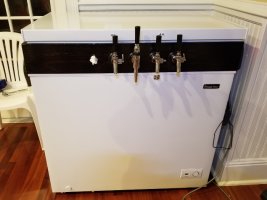I feel like the Emperor in Return of the Jedi. "Now witness the power of this fully armed and operational beer station." The keezer is up and running.
Okay, it's not fully armed, but it's operational. The tap on the right is hooked up to my keg of ale. I didn't order enough shanks, so I have a wad of paper towel stuffed in the hole where the remaining faucet goes.
The frame is anything but square. I have learned that there are some things Kreg jigs do well and some things they do not. Maybe I'll brace the inside with steel to force it into line. If I can get it square, I can attach hardwood to the outside later so the irredeemable 2x6's are covered. I don't know if pine quality is getting worse or what. This stuff is horrible. There is no way to make it look nice.
I learned some things that could help other Magic Chef 8.7 owners.
The wire for the lid light is long enough to cross a 5-1/4" collar. You have to remove the cover on the back of the freezer, turn the cover upside-down, and run the wire out of the top instead of the bottom. The cover is held in by screws and a thin foamy adhesive. A spudger will cut the adhesive so you can pull the cover off. The cable is attached to the freezer with clips you can open so you can remove the lid and set it aside.
The plastic hinge covers and the lid handle come off without destruction. You just slide a screwdriver behind them and move it along until it pops them off. The hinges have springs, but they won't fly open violently and cause problems. They will stay in place while you screw them to your collar.
Now here is what may be the worst picture I've taken in my entire life.
Okay, it's not fully armed, but it's operational. The tap on the right is hooked up to my keg of ale. I didn't order enough shanks, so I have a wad of paper towel stuffed in the hole where the remaining faucet goes.
The frame is anything but square. I have learned that there are some things Kreg jigs do well and some things they do not. Maybe I'll brace the inside with steel to force it into line. If I can get it square, I can attach hardwood to the outside later so the irredeemable 2x6's are covered. I don't know if pine quality is getting worse or what. This stuff is horrible. There is no way to make it look nice.
I learned some things that could help other Magic Chef 8.7 owners.
The wire for the lid light is long enough to cross a 5-1/4" collar. You have to remove the cover on the back of the freezer, turn the cover upside-down, and run the wire out of the top instead of the bottom. The cover is held in by screws and a thin foamy adhesive. A spudger will cut the adhesive so you can pull the cover off. The cable is attached to the freezer with clips you can open so you can remove the lid and set it aside.
The plastic hinge covers and the lid handle come off without destruction. You just slide a screwdriver behind them and move it along until it pops them off. The hinges have springs, but they won't fly open violently and cause problems. They will stay in place while you screw them to your collar.
Now here is what may be the worst picture I've taken in my entire life.






![Craft A Brew - Safale S-04 Dry Yeast - Fermentis - English Ale Dry Yeast - For English and American Ales and Hard Apple Ciders - Ingredients for Home Brewing - Beer Making Supplies - [1 Pack]](https://m.media-amazon.com/images/I/41fVGNh6JfL._SL500_.jpg)




















































